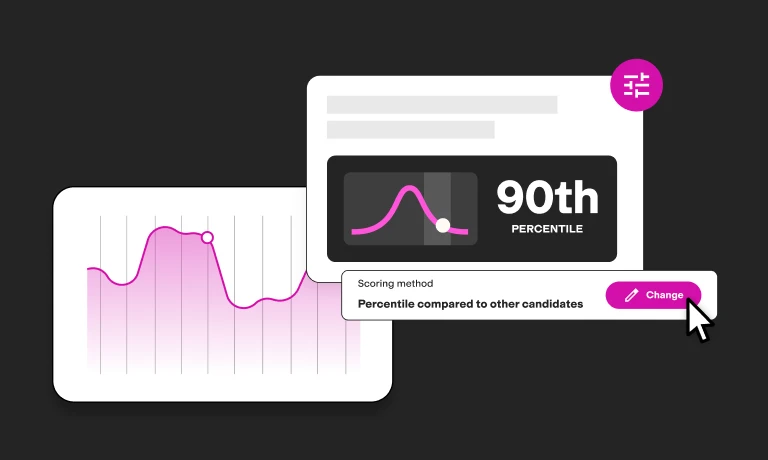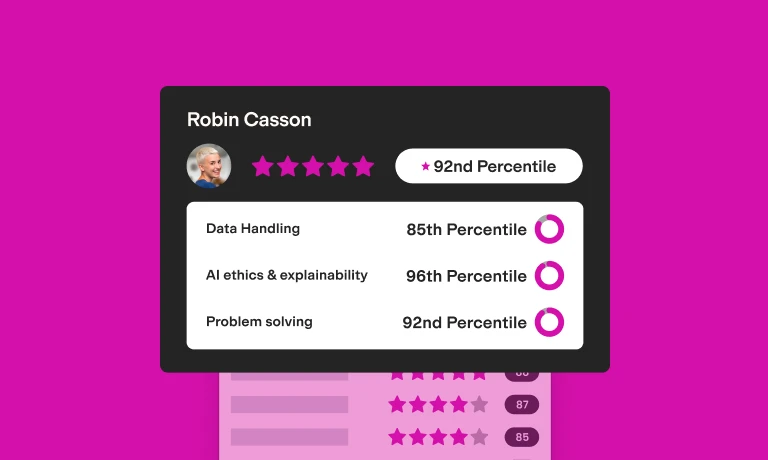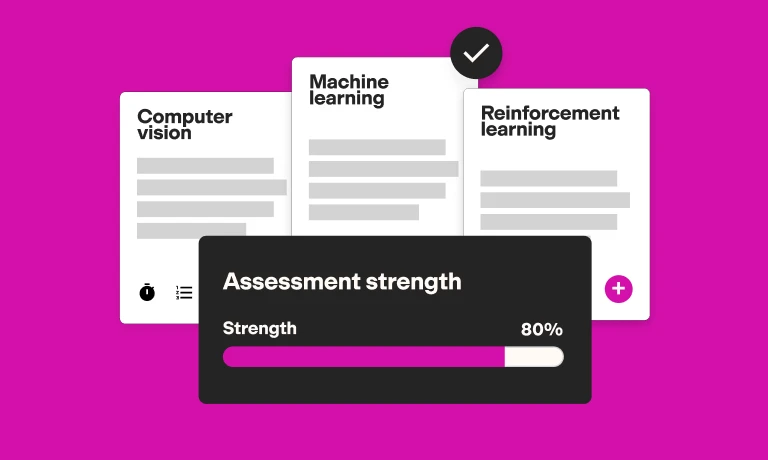27 tricky C# interview questions to add to your hiring campaign (and answers to look for)
Hire top C# developers with TestGorilla
C# is a programming language used to develop applications, games, and more. Currently, it’s the fifth most popular programming language in the world. [1] With so many professionals using the language, finding the right developer for a C# role can be challenging. You must have a robust, accurate understanding of your applicants’ skills and expertise to be sure you truly select the best of the best.
While a talented developer can help you develop and deploy products effectively, a mis-hire can lead to missed deadlines, buggy applications, and disruption to the entire team’s workflow. This can cause your organization to lose opportunities and your reputation to take a hit with customers.
Therefore, creating a comprehensive candidate assessment process that includes tricky C# interview questions is crucial.
In this article, we share 27 complex questions to ask C# developers during interviews. These questions help you get a complete picture of your candidates’ theoretical knowledge, practical expertise, and situational judgment. We’ve also provided example answers so you know what to listen for.
What are tricky C# interview questions?
The ideal candidate for a C# role has a strong grasp of the language, including how to implement it effectively for business use cases. While basic questions can test a candidate’s familiarity with the language, they typically can’t test how they will react in real-life work scenarios.
This is when tricky C# interview questions are helpful. These questions assess a candidate’s proficiency in C#’s more advanced concepts and features. They also require developers to think critically and demonstrate their problem-solving abilities.
Advanced questions show you how a developer would respond within the context of the specific role and its responsibilities. This enables you to find the best-suited candidate for your open positions.
Tricky C# interview questions can comprise:
Theoretical questions asking candidates to explain a C# concept, its functionalities, and its principles.
Practical questions, which enable candidates to show their C# skills by asking them to write code for specific projects or tasks.
Scenario-based questions that present candidates with an example scenario to test their coding and problem-solving on the spot.
Why include C# tricky questions in interviews?
Tricky C# interview questions are the key to evaluating a candidate’s skills, suitability for the position, and overall potential contribution to your development team. Plus, these questions help you remove bias from the hiring process, as they give you a way to compare candidates objectively and identify top talent.
In particular, adding tricky questions in interviews can help you assess:
Technical expertise and understanding of best practices
These questions go beyond basic syntax and standard concepts, revealing a candidate’s ability to handle complex scenarios. They enable you to identify developers who deeply understand advanced C# topics and how to use them to solve coding problems.
Plus, these questions help you measure whether candidates know the best practices for writing efficient and maintainable code. Many advanced questions revolve around performance optimization, memory management, and design patterns.
Critical thinking and problem-solving skills
Tricky questions also assess applicants’ problem-solving skills and ability to approach challenging coding scenarios. It’s crucial for you to understand how a developer has tackled past problems, as it’s a strong indicator of how they’ll approach challenges at your organization if they’re hired.
Versatility and learning potential
Complex questions evaluate a candidate’s versatility in using C# to solve problems – which is crucial in software development, where different projects demand different skill sets.
Additionally, a candidate’s response to advanced questions reveals their potential for learning and growth. Those who engage well with these questions will likely adapt to new challenges and learn quickly on the job.
Communication skills
A developer might have all the right skills for the position, but without clear communication, they’re unlikely to succeed in your organization. Candidates who can answer difficult questions and break down complex subjects in an interview will likely be able to communicate clearly and collaborate effectively within your team.
The best insights on HR and recruitment, delivered to your inbox.
Biweekly updates. No spam. Unsubscribe any time.
27 tricky C# interview questions and answers
Use the following questions to ensure your candidate has the necessary C# skills and expertise to succeed at your organization. We’ve included sample answers for each question so you can listen for ideal answers.
1. What is the difference between IEnumerable and IQueryable interfaces in C#? When would you use each one?
IEnumerable is used for querying in-memory collections, while IQueryable is used for querying external data sources, like databases. IQueryable allows you to write and execute more complex queries on the server.
2. What are the differences between async/await and Task.Run in C# when dealing with asynchronous code?
Async/await is used to create asynchronous methods that can be awaited without blocking the main thread. Task.Run is used to execute a delegate or lambda expression on a ThreadPool thread asynchronously. It can be helpful to offload CPU-bound work from the main thread.
3. Explain the various methods of sharing data between tasks in C#.
Data can be shared between tasks using thread-safe data structures like
ConcurrentDictionary and ConcurrentQueue or synchronization constructs like lock, Monitor, and Semaphore.
4. How do you implement a custom exception handling middleware in ASP.NET Core?
Here’s a summary of the process:
Implement a custom middleware that handles exceptions.
Use app.UseMiddleware to add the middleware to the application’s request pipeline.
In the middleware, catch exceptions, log them, and return an appropriate response.
5. How do you implement a custom attribute in C#? Provide an example of how to use it to decorate a class.
Implement a custom attribute by creating a class that derives from Attribute. Add properties or fields to store data associated with the attribute. To use the attribute, apply it to classes or members using square bracket syntax.
Here’s an example:
[AttributeUsage(AttributeTargets.Class)]
public class CustomAttribute : Attribute
{
public string Name { get; set; }
public CustomAttribute(string name)
{
Name = name;
}
}
[Custom("ExampleClass")]
public class MyClass
{
// Class implementation
}
6. Explain the differences between covariance and contravariance in C# for delegates and interfaces.
Covariance allows using a more derived type instead of a less derived type, while contravariance enables the opposite. In C#, covariance can be applied to interfaces using the out keyword, and contravariance can be applied using the in keyword.
7. How do you handle deadlocks in multi-threaded C# applications?
Deadlocks occur when multiple threads are blocked, waiting for each other to release resources. To handle deadlocks, follow best practices like acquiring locks in a consistent order, using timeout mechanisms, and avoiding long-running locks.
8. Explain the using directive and the using statement in C#. What are their differences?
The using directive is used to include namespaces in a file, making types in those namespaces accessible without fully qualifying their names. The using statement is used for the automatic disposal of resources that implement IDisposable.
9. Explain the differences between value types and reference types in C#.
Value types store their value directly in memory, while reference types store a reference to an object in memory. Value types are stored on the stack, and reference types are stored on the heap.
10. How do you implement a custom IComparer<T> for sorting in C#?
Create a class that implements the IComparer<T> interface, defining the Compare method for comparing two objects. Then, use an instance of this custom comparer with the Sort method of a collection to apply your customized sorting logic.
11. Explain the concept of object pooling in C# and its benefits in multi-threaded applications.
Object pooling involves reusing objects instead of creating new ones. This can improve performance and reduce garbage collection overhead, especially in multi-threaded applications, where object creation and destruction can be costly.
12. How can you improve string concatenation performance in C#?
Use StringBuilder instead of repeated string concatenation with + to improve performance, especially when concatenating or linking multiple strings together in a loop.
13. What are delegates and events in C#? Provide an example of using events in a C# application.
Delegates are function pointers that enable encapsulating a method and calling it indirectly. Events are a way to provide notifications to other parts of the application when something happens.
Here’s an example:
public delegate void EventHandler(object sender, EventArgs e);
public class EventPublisher
{
public event EventHandler SomethingHappened;
public void DoSomething()
{
// ... do something
OnSomethingHappened();
}
protected virtual void OnSomethingHappened()
{
SomethingHappened?.Invoke(this, EventArgs.Empty);
}
}
14. What are the different types of garbage collection in C#? How can you configure them?
C# supports three types of garbage collection: Workstation garbage collection, Server garbage collection, and Concurrent garbage collection. You can configure garbage collection behavior using configuration settings in the app’s configuration file.
15. Explain the differences between a deep copy and a shallow copy of objects in C#. How can you perform each type of copy?
A shallow copy creates a new object but doesn’t duplicate internal references. A deep copy creates a new object and clones all internal references recursively. Shallow copying can be done using MemberwiseClone, while deep copying requires custom implementation.
16. What is reflection in C#? How is it useful, and what are its limitations?
Reflection allows inspecting and manipulating types, methods, properties, etc., at runtime. It’s useful for building generic frameworks and creating dynamic and extensible applications. However, it can be slower and lacks compile-time safety.
17. What is the purpose of the yield keyword in C#? Provide an example of using it with an iterator.
The yield keyword is used to create an iterator in C#. It allows you to return a sequence of values without building the entire sequence in memory before returning it.
For example:
public IEnumerable<int> GetNumbers()
{
for (int i = 0; i < 10; i++)
{
yield return i;
}
}
18. Explain how to implement a custom serializer and deserializer for a complex object in C#.
You can implement custom serialization logic by manually converting the object’s properties to a serialized format (e.g., JSON or XML). Then, implement the deserialization logic to read the serialized data and recreate the object.
19. Explain the differences between Memory<T> and Span<T> in C#. When would you use one over the other?
Memory<T> represents a chunk of memory that can be read from and written to. Span<T> is a lightweight view of a portion of an array or memory.
Use Memory<T> when you need a dynamically allocated memory block and Span<T> to work with a portion of an existing array or memory.
20. How can you optimize memory usage and performance when working with large data collections in C#?
You can consider using data structures that are more memory-efficient for specific scenarios, like BitArray for managing sets of bits or HashSet<T> for effective membership checks. Also, you can use streaming and lazy-loading techniques to avoid loading the entire data set into memory.
21. What are extension methods in C#? Provide an example of using an extension method with an existing class.
Extension methods are created by defining static methods within static classes. The “this” keyword is used in the method's parameter to indicate the type being extended.
For example:
public static class StringExtensions{ public static bool IsPalindrome(this string str)
{
// Check if the string is a palindrome
// ...
}
}
// Usage:
string word = "racecar";
bool isPalindrome = word.IsPalindrome(); // true
22. How do you work with parallelism and concurrency in C#? Explain the differences between Parallel.ForEach and PLINQ (Parallel LINQ).
Parallel.ForEach is used to parallelize the iteration over a collection, while PLINQ allows performing parallel queries on data using LINQ. Use Parallel.ForEach when you need to apply a function to each element of a collection in parallel. Use PLINQ when you want to perform data queries in parallel.
23. How does the volatile keyword work in C#? When and how should you use it?
The volatile keyword is used to ensure that the value of a variable is always read from and written to the main memory, not from a cache. Use it when you have a variable shared between multiple threads and want to avoid potential visibility issues or stale values.
24. Explain the differences between async void and async Task in C#. When would you use one over the other?
async void is used for event handlers and should be avoided in most other scenarios since it makes error handling more difficult. async Task is used for asynchronous methods that return a result and allow better error handling through Tasks’ Exception property.
25. What is boxing and unboxing in C#? How can you avoid performance issues related to boxing?
Boxing is the process of converting a value type to an object type, and unboxing is the reverse process. Boxing and unboxing can cause performance overhead. To avoid it, use generics (List<T>, Dictionary<TKey, TValue>, etc.) over non-generic collections (ArrayList, Hashtable, etc.), and use generic versions of interfaces like IEnumerable<T> instead of non-generic versions like IEnumerable.
26. What is a Singleton design pattern?
The singleton pattern ensures that a class has only one instance and provides a global point of access to that instance. It typically involves a private constructor and a static method to retrieve the instance.
27. Explain the Factory Method design pattern.
The factory Method pattern defines an interface for creating objects, but allows the sub class to decide which class to instantiate. It promotes loose coupling between the client code and the objects.
How to include tricky C# interview questions in your hiring campaign
Advanced C# questions are a great way to get more detailed insight into your candidates’ skills. But they aren’t enough to make up your entire assessment process. It’s important to pair these questions with additional tests to get a clear picture of your prospective hires.
TestGorilla’s multi-measure testing technique can help you make bias-free, well-informed hiring decisions. Use a combination of our 300+ tests to comprehensively evaluate candidates’ skills and qualifications for the C# role, along with their personality traits, cognitive ability, and more.
With TestGorilla, you can evaluate C# developers by creating assessments that include:
Job-specific skills tests, including C# debugging, algorithms, and data structures tests.
Personality tests, like Enneagram and DISC, to understand applicants’ behavioral traits.
Soft skills tests, such as our Motivation test, Communication skills test, and more.
Custom questions tailored to the position and your company.
By combining tricky interview questions with TestGorilla’s skills and personality tests, you can be confident in hiring the best developers for your organization.
Have you tried our soft skills assessments?
Level up your recruiting with soft skills assessments from TestGorilla.
Find skilled C# developers with TestGorilla
Finding highly-qualified developers for a C# position requires going beyond basic testing and questions. You must use complex C# questions that challenge candidates and provide in-depth insights into their knowledge and skills.
Using these tricky questions alongside TestGorilla’s range of programming and personality tests enables you and your hiring team to assess candidates accurately, reduce unconscious bias during hiring, and prevent mis-hires that can harm your business.
Sign up for TestGorilla’s free plan to explore our tests, or get a free 30-minute live demo to see how they can elevate your hiring campaigns.
Source:
1. (n.d.). TIOBE Index for August 2023. Tiobe Index. Retrieved August 25, 2023, from https://www.tiobe.com/tiobe-index/
You've scrolled this far
Why not try TestGorilla for free, and see what happens when you put skills first.

















